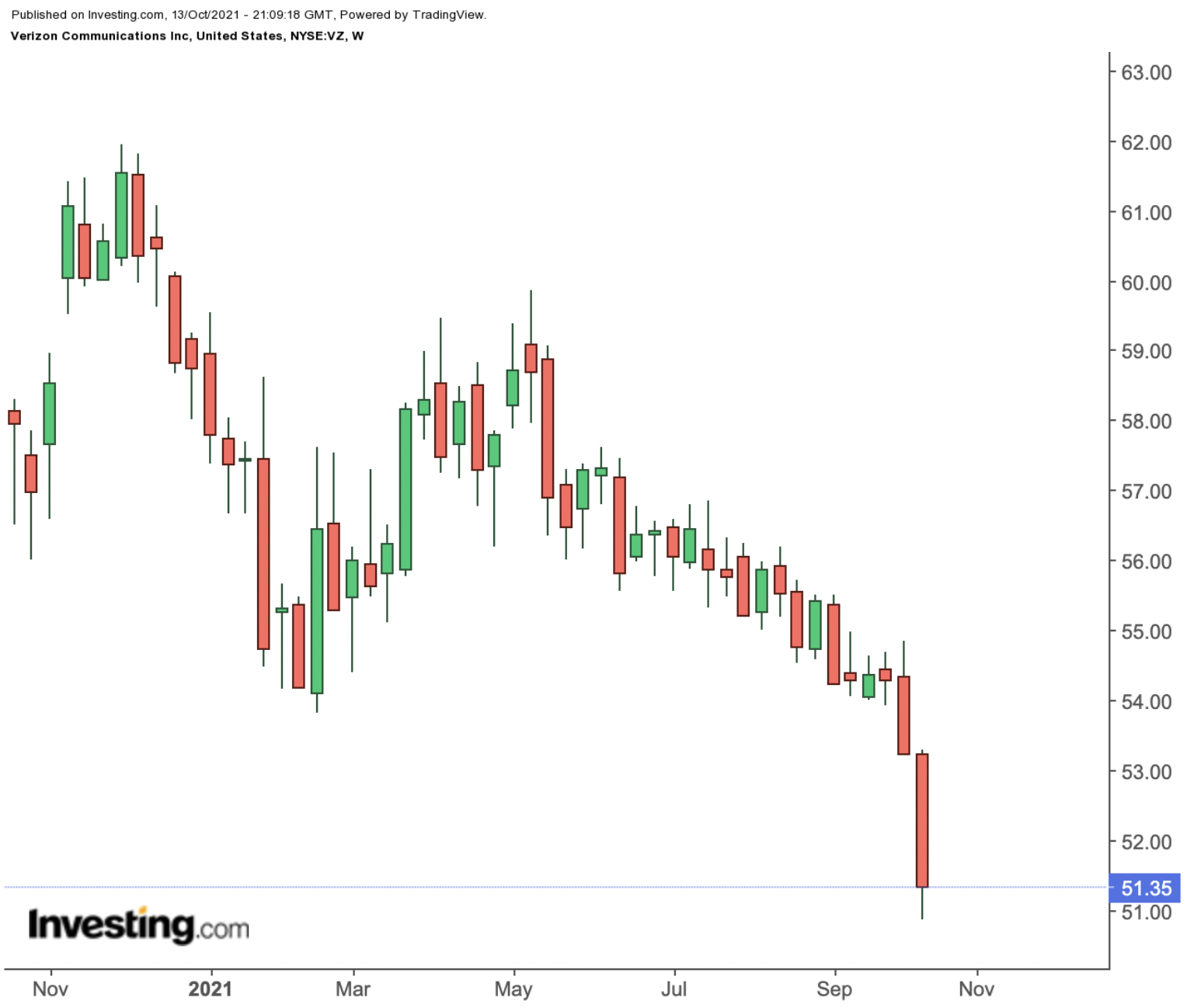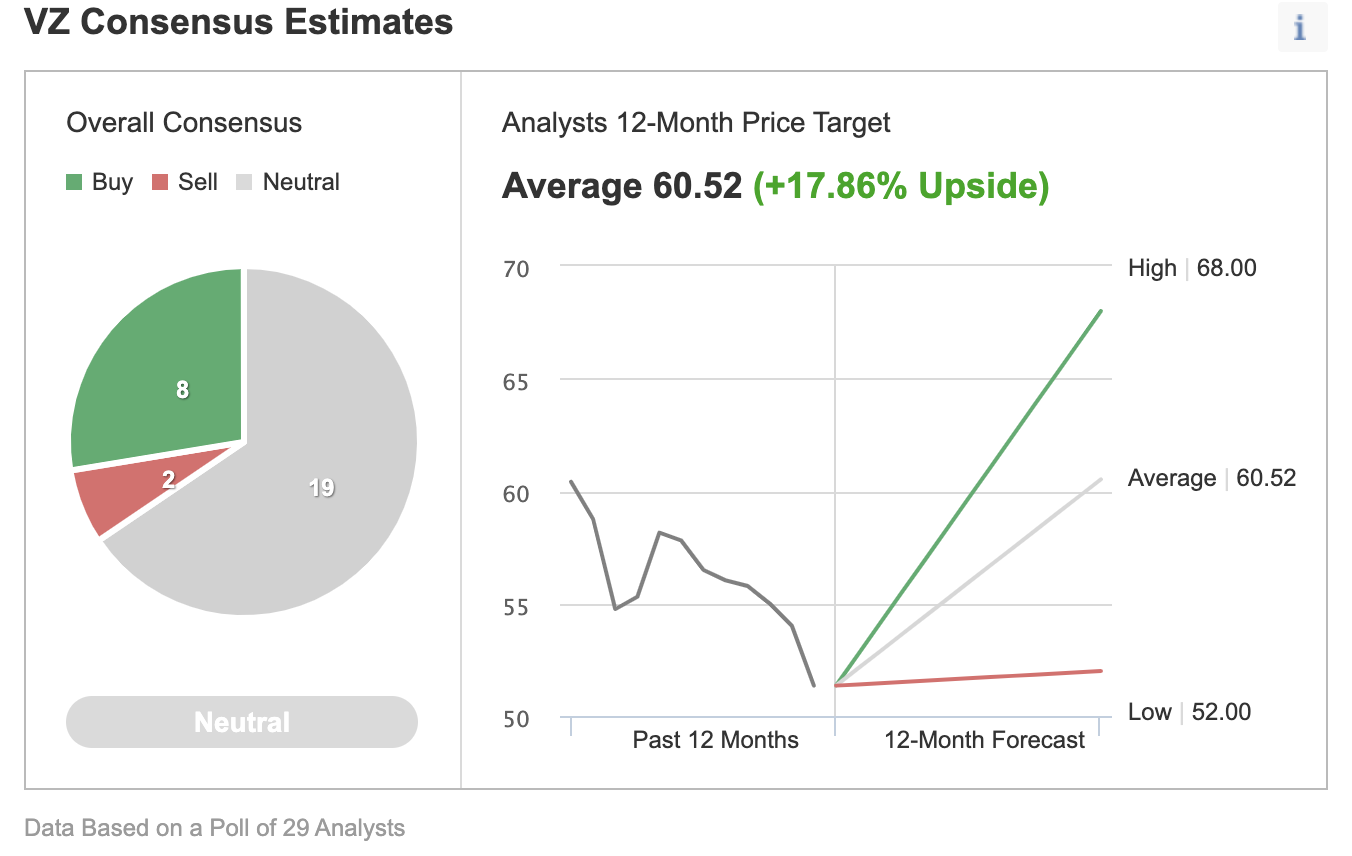- Verizon is down more than 13% so far in 2021, and saw a 52-week low on Oct. 13.
- VZ stock currently supports a dividend yield of 5.01%.
- Despite potential short-term volatility in the stock, buy-and-hold investors could regard any further short-term decline as an opportune entry point
Investors in telecom giant Verizon Communications (NYSE:VZ) have seen their shares lose 13.2% so far this year. In fact, the stock hit a 52-week intraday low of $50.86 on Oct. 13. The last time VZ stock traded around $50 was in the initial days of the pandemic in March 2020, when shares found support around $49.

Verizon shares closed yesterday at $51.35, and the current price means a dividend yield of 4.99%. The 52-week range for the stock has been $50.86 (October 2021) - $61.95 (December 2020), while the company’s market capitalization stands at $211.68 billion.
Readers might be interested to know that share prices of the two other telecom competitors, AT&T (NYSE:T) and T-Mobile US (NASDAQ:TMUS), are also down 12.3% and 12.9% in 2021. In fact, T stock hit a multi-year intraday low of $25.01 on Oct. 13.
All three of these stocks have been focusing on the rollout of the 5G network in the US. Verizon is also one of the leading stocks held by Warren Buffett’s Berkshire Hathaway (NYSE:BRKa) (NYSE:BRKb) (discussed here).
Verizon is expected to release Q3 earnings on Oct. 20 before the market open. At that time, in addition to regular metrics, investors will want to know more about how the advent of 5G is impacting the top-line as well as the telecom’s debt load, which stands around $150 billion.
What To Expect From V Stock
Among 29 analysts polled via Investing.com, Verizon stock has a 'neutral' rating. The shares have a 12-month price target of $60.52, implying an increase of about 18.5% from current levels. The 12-month price range currently stands between $52 and $68.

Trailing P/E, P/S and P/B ratios for VZ stock stand at 10.64x, 1.6x and 2.88x, respectively. We believe long-term investors could begin to find value around these levels.
By comparison, the same metrics for TMUS stand at 37.2x, 1.83x, and 2.15. And the P/S and P/B ratios for T are 1.03x and 1.12x.
Readers who watch technical charts might be interested to know that a number of Verizon's short- and intermediate-term oscillators are oversold. Although they can stay extended for weeks—if not months—the decline in price could also be coming to an end.
Our expectation is for Verizon to find strong support at the $50 level. Although it might initially dip below this important level, it is likely to bounce back before too long. Afterward, the shares would likely trade sideways while it establishes a new base.
3 Possible Trades On Verizon Stock
1. Buy VZ Stock At Current Levels
Investors who are not concerned with daily moves in price and who believe in the long-term potential of the company could consider investing in Verizon stock now.
Yesterday, Verizon closed at $51.35. Buy-and-hold investors should expect to keep this long position for several months, if not multiple quarters, while the stock makes an attempt at analysts' price target of $60.52.
Then, the next step would be the recent multi-year high of $61.95. Such a move would lead to a return of more than 20.5% from the current level.
Readers who opt for this approach, but are concerned about large declines, might also consider placing a stop-loss at about 3%-5% below their entry point.
2. Buy An ETF With VZ As A Main Holding
Many readers are familiar with the fact that we regularly cover exchange-traded funds (ETFs) that might be suitable for buy-and-hold investors. Thus, those who do not want to commit capital to Verizon stock, but would still like to have substantial exposure to the shares, could consider researching a fund that holds the company as a top holding.
Examples of such ETFs include:
- iShares US Telecommunications ETF (NYSE:IYZ): This fund is up 5.0% YTD, and VZ stock’s weighting is 14.12%;
- Invesco Dow Jones Industrial Average Dividend ETF (NYSE:DJD): This fund is up 12.4% YTD, and VZ stock’s weighting is 6.69%;
- Vanguard Communication Services Index Fund ETF Shares (NYSE:VOX): The fund is up 16.8% YTD, and VZ stock’s weighting is 4.24%;
- VictoryShares US Multi-Factor Minimum Volatility (NASDAQ:VSMV): The fund is up 13.3% YTD, and VZ stock’s weighting is 3.22%.
3. Cash-Secured Put Selling
Investors who believe the decline in Verizon could soon come to an end might consider selling a cash-secured put option in VZ stock—a strategy we regularly cover. As it involves options, this set-up will not be appropriate for all investors.
Such a bullish trade could especially appeal to those who want to receive premiums (from put selling) or to possibly own Verizon shares for less than their current market price of $51.35.
A put option contract on VZ stock is the option to sell 100 shares. Cash-secured means the investor has enough money in his or her brokerage account to purchase the security if the stock price falls and the option is assigned. This cash reserve must remain in the account until the option position is closed, expires, or the option is assigned, which means ownership has been transferred.
Let's assume an investor wants to buy Verizon stock, but does not want to pay the full price of $51.35 per share. Instead, the investor would prefer to buy the shares at a discount within the next several months.
One possibility would be to wait for VZ stock to fall, which it might or might not do. The other possibility is to sell one contract of a cash-secured Verizon put option.
So the trader would typically write an at-the-money (ATM) or an out-of-the-money (OTM) put option and simultaneously set aside enough cash to buy 100 shares of the stock.
Let's assume the trader is putting in this trade until the option expiry date of Dec. 21, 2022. As the stock is $51.35 at time of writing, an OTM put option would have a strike of $50.00.
So the seller would have to buy 100 shares of Verizon at the strike of $50.00 if the option buyer were to exercise the option to assign it to the seller.
The VZ Dec. 21, 2022, 50-strike put option is currently offered at a price (or premium) of $1.48.
An option buyer would have to pay $1.48 X 100, or $148, in premium to the option seller. This premium amount belongs to the option seller no matter what happens in the future. The put option will stop trading on Friday, Jan. 21.
Assuming a trader would enter this cash-secured put option trade at $51.35 now, at expiration on Jan. 21, the maximum return for the seller would be $148, excluding trading commissions and costs.
The seller's maximum gain is this premium amount if VZ stock closes above the strike price of $50.00. Should that happen, the option expires worthless.
If the put option is in the money (meaning the market price of Verizon stock is lower than the strike price of $50.00) any time before or at expiration on Jan. 21, this put option can be assigned. The seller would then be obligated to buy 100 shares of VZ stock at the put option's strike price of $50.00 (i.e., at a total of $5,000).
The break-even point for our example is the strike price ($50.00) less the option premium received ($1.48), i.e., $48.52. This is the price at which the seller would start to incur a loss.
Cash-secured put selling is a moderately more conservative strategy than buying shares of a company outright at the current market price. This can be a way to capitalize on the choppiness in VZ stock in the coming weeks.
Investors who end up owning Verizon shares as a result of selling puts could further consider setting up covered calls to increase the potential returns on their shares. Thus, selling cash-secured puts could be regarded as the first step in stock ownership.
